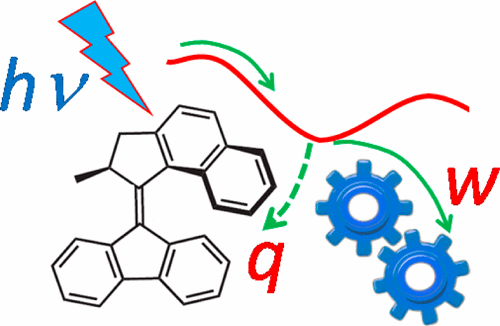当前位置:
X-MOL 学术
›
J. Am. Chem. Soc.
›
论文详情
Our official English website, www.x-mol.net, welcomes your feedback! (Note: you will need to create a separate account there.)
Ultrafast Dynamics in Light-Driven Molecular Rotary Motors Probed by Femtosecond Stimulated Raman Spectroscopy
Journal of the American Chemical Society ( IF 15.0 ) Pub Date : 2017-05-10 00:00:00 , DOI: 10.1021/jacs.7b03599 Christopher R. Hall 1 , Jamie Conyard 1 , Ismael A. Heisler 1 , Garth Jones 1 , James Frost 1 , Wesley R. Browne 2 , Ben L. Feringa 3 , Stephen R. Meech 1
Journal of the American Chemical Society ( IF 15.0 ) Pub Date : 2017-05-10 00:00:00 , DOI: 10.1021/jacs.7b03599 Christopher R. Hall 1 , Jamie Conyard 1 , Ismael A. Heisler 1 , Garth Jones 1 , James Frost 1 , Wesley R. Browne 2 , Ben L. Feringa 3 , Stephen R. Meech 1
Affiliation

|
Photochemical isomerization in sterically crowded chiral alkenes is the driving force for molecular rotary motors in nanoscale machines. Here the excited-state dynamics and structural evolution of the prototypical light-driven rotary motor are followed on the ultrafast time scale by femtosecond stimulated Raman spectroscopy (FSRS) and transient absorption (TA). TA reveals a sub-100-fs blue shift and decay of the Franck–Condon bright state arising from relaxation along the reactive potential energy surface. The decay is accompanied by coherently excited vibrational dynamics which survive the excited-state structural evolution. The ultrafast Franck–Condon bright state relaxes to a dark excited state, which FSRS reveals to have a rich spectrum compared to the electronic ground state, with the most intense Raman-active modes shifted to significantly lower wavenumber. This is discussed in terms of a reduced bond order of the central bridging bond and overall weakening of bonds in the dark state, which is supported by electronic structure calculations. The observed evolution in the FSRS spectrum is assigned to vibrational cooling accompanied by partitioning of the dark state between the product isomer and the original ground state. Formation of the product isomer is observed in real time by FSRS. It is formed vibrationally hot and cools over several picoseconds, completing the characterization of the light-driven half of the photocycle.
中文翻译:

飞秒激发拉曼光谱探测光驱动分子旋转马达的超快动力学
空间拥挤的手性烯烃中的光化学异构化是纳米级机器中分子旋转马达的驱动力。在此,飞秒激发拉曼光谱(FSRS)和瞬态吸收(TA)在超快的时间尺度上跟踪原型光驱动旋转电机的激发态动力学和结构演变。TA揭示了沿无功势能表面的弛豫引起的Franck-Condon亮态的亚100-fs蓝移和衰减。衰减伴随着相干激发的振动动力学,该动力学动力学在激发态结构演化过程中得以幸存。弗兰克-康登(Franck-Condon)超快态从松弛状态转变为暗态激发状态,与电子基态相比,FSRS揭示了该光谱具有丰富的光谱,拉曼激活模式最强烈时,波数会大大降低。通过减少中心桥键的键序和在黑暗状态下键的整体弱化来讨论此问题,这由电子结构计算来支持。FSRS光谱中观察到的演变与振动冷却有关,伴随有产物异构体和原始基态之间的暗态分配。通过FSRS实时观察到产物异构体的形成。它在振动时形成,并在数皮秒内冷却,从而完成了光周期中光驱动的一半的表征。电子结构计算支持这一点。FSRS光谱中观察到的演变与振动冷却有关,伴随有产物异构体和原始基态之间的暗态分配。通过FSRS实时观察到产物异构体的形成。它在振动时形成,并在数皮秒内冷却,从而完成了光周期中光驱动的一半的表征。电子结构计算支持这一点。FSRS光谱中观察到的演变与振动冷却有关,伴随有产物异构体和原始基态之间的暗态分配。通过FSRS实时观察到产物异构体的形成。它在振动时形成,并在数皮秒内冷却,从而完成了光周期中光驱动的一半的表征。
更新日期:2017-05-23
中文翻译:

飞秒激发拉曼光谱探测光驱动分子旋转马达的超快动力学
空间拥挤的手性烯烃中的光化学异构化是纳米级机器中分子旋转马达的驱动力。在此,飞秒激发拉曼光谱(FSRS)和瞬态吸收(TA)在超快的时间尺度上跟踪原型光驱动旋转电机的激发态动力学和结构演变。TA揭示了沿无功势能表面的弛豫引起的Franck-Condon亮态的亚100-fs蓝移和衰减。衰减伴随着相干激发的振动动力学,该动力学动力学在激发态结构演化过程中得以幸存。弗兰克-康登(Franck-Condon)超快态从松弛状态转变为暗态激发状态,与电子基态相比,FSRS揭示了该光谱具有丰富的光谱,拉曼激活模式最强烈时,波数会大大降低。通过减少中心桥键的键序和在黑暗状态下键的整体弱化来讨论此问题,这由电子结构计算来支持。FSRS光谱中观察到的演变与振动冷却有关,伴随有产物异构体和原始基态之间的暗态分配。通过FSRS实时观察到产物异构体的形成。它在振动时形成,并在数皮秒内冷却,从而完成了光周期中光驱动的一半的表征。电子结构计算支持这一点。FSRS光谱中观察到的演变与振动冷却有关,伴随有产物异构体和原始基态之间的暗态分配。通过FSRS实时观察到产物异构体的形成。它在振动时形成,并在数皮秒内冷却,从而完成了光周期中光驱动的一半的表征。电子结构计算支持这一点。FSRS光谱中观察到的演变与振动冷却有关,伴随有产物异构体和原始基态之间的暗态分配。通过FSRS实时观察到产物异构体的形成。它在振动时形成,并在数皮秒内冷却,从而完成了光周期中光驱动的一半的表征。


























 京公网安备 11010802027423号
京公网安备 11010802027423号